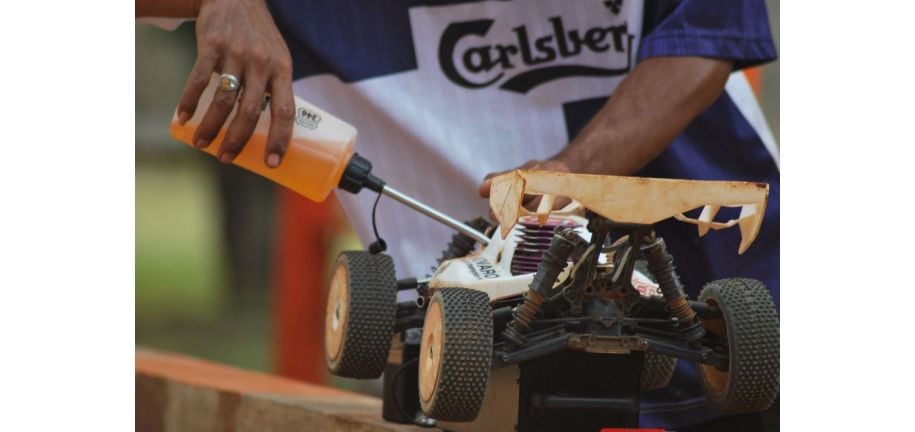What's the Difference Between Nitro and Petrol RC Cars?
For decades, debates have been rife about whether nitro or petrol engines in RC cars are superior.Amid these heated arguments between hobbyists, both teams are solidly planted on their respective sides of the fence. To help with your decision, At Models has produced a comprehensive guide on all things RC cars.
Let's talk mechanics.
Nitro Engines
Nitro engines use glow plugs for ignition. The glow plug's circuit must be heated using an external ~1.5v battery glow igniter. While various glow igniters are available, rechargeable ones are the most common and are frequently included in nitro starter kits. The glow igniter can be withdrawn from the plug once the nitro engine has been successfully started, as the intense heat produced by combustion will cause the engine to re-ignite.
Petrol Engines
Petrol engines use spark plugs; the spark is produced by the movement of magnets past a coil typically mounted on the flywheel. Since this occurs automatically whenever the engine is turned over, glow igniters or other starting equipment are not required.
Is there a fuel difference?
Yes! Nitro fuel combines nitromethane, methanol and oil, whereas a Petrol RC Car requires 2-Stroke fuel, a combination of Unleaded petrol and 2-Stroke oil.
Pros and Cons of Nitro RC cars

A general misconception about nitro-powered RC cars, buggies, and trucks is that they are the optimum choice when taking up the hobby. Here at AT models, we like to weigh our options, so read on and discover which RC car is ideal for you.
Pros
- Nitro RC cars have long run times, high power outputs, and a vehicle's realistic sound and smell due to the small Nitromethane-based engine.
- Before the development of brushless technology in electric vehicles, nitro-powered cars were the fastest. However, they are still a popular racing option and are capable of speeds of 50 mph.
- Even though they are on the heavier side, the weight of an RC car is evenly distributed compared to petrol RC cars to allow for maximum performance.
- Nitro cars have the notable benefit of operating for 10 to 15 minutes on a full tank before needing to be quickly refuelled while their engine is still running. This means that they can effectively function all day.
- Compared to other RC vehicles, nitro engines are incredibly loud. However, some drivers greatly appreciate this feature as it seems more thrilling and realistic.
- The individual parts are relatively cheap to replace. For example, materialslike glow plugs only cost a few pounds.
Cons
- Internal combustion engines require a reasonable amount of maintenance. This may entail draining the fuel tank, checking the clutch, tightening screws, cleaning the air filter, and adjusting the carburettor needles.
- A 3-5 tank engine break-in period is necessary for each brand-new nitro-powered RC car to ensure long-lasting efficiency and engine life; this step is essential.
- Unpredictable minor faults are inevitable in any engine, so remember you will have to do some tinkering.
- Nitro Cars need a deeper cleaning after use as the engine oil causes the car to become very dirty. However, some individuals adore this feature and are content to continuously modify the engine.
- Prepare for ongoing costs associated with RC car consumables like glow plugs, after-run oil, air filter oil, and nitro fuel.
- Due to nitro RC car fuel, these cars are the most costly to maintain. Each use typically consumes at least one tank of fuel, which is more expensive than regular petrol at around £17 per litre on average. What’s more, if you don't live close to an RC hobby shop, finding fuel can be more of a challenge.
Pros and Cons of Petrol RC Cars.
Pros
- The running time of these cars is superior to others, lasting between 40-50 minutes on a tank of fuel.
- The radio console and car batteries need charging before a set-up, and you must fill the fuel tank. The only other preparation required for these vehicles is priming the engine before use, which is less fiddly and complicated than with a nitro car.
- Although they require a fair bit of cleaning due to engine oil, petrol vehicles are far less maintenance than nitro engines.
- Petrol RC cars are a more cost-effective option, as they use fuel that can be sourced from any service station at regular prices. The engines are also more fuel efficient than nitro engines.
Cons
- Compared to nitro versions, they are slower and less powerful. Because of the size of the models, this is generally accepted; if they moved any quicker, they might become dangerous.
- Despite their relative size, they are heavier than other cars, and this weight is not spread equally like in nitro engines. Therefore, they may be more challenging to manage because of the uneven weight distribution.
- Petrol-powered cars are loud but less noisy and authentic than nitro models. Some enthusiasts prefer the noise of a petrol RC. We'll leave that up to you!
- Petrol cars are generally more expensive, as they come in larger model sizes to accommodate the engine.
To find the perfect RC car, take time to research, and ensure you choose one that you'll love building and tinkering with for years to come.
Should you have any questions, pleasecontact our friendly team of experts, who’ll be happy to help!
Alternatively, share your hobby with our team and other RC enthusiasts and connect with us onFacebook,Twitter andYouTube!


